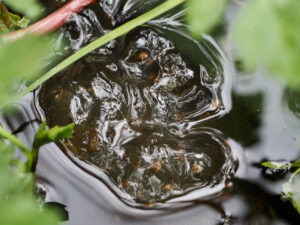By Geoff Hammerson

The earliest breeders are long-toed salamanders, northwestern salamanders, and northern red-legged frogs. It’s easy to miss these winter events because the secretive salamanders go about their activities in silence, and red-legged frogs call softly, often while completely submerged. You may discover the clumps of jelly-enclosed embryos of these amphibians in the water right now.

Rough-skinned newts can be seen plodding along in any month, especially during and after rainy weather. Watch out for them as they migrate across roads when temperatures are at least in the mid-40s F. Newts scatter single eggs in the water mostly in March and April.
Western toads generally wait for the warmer days of April or May
before depositing their long strings of eggs in pond or lake shallows.
Their unobtrusive vocalizations consist of soft chirps given by the
males as they bump into one another at breeding sites. In summer, you
may see countless thousands of tiny toadlets emerging from Anderson
Lake.

Pacific treefrogs are our loudest amphibian. Boisterous choruses of vibrant “crek-ek” calls come and go over a relatively long season in
late winter and spring. With a headlamp at night, you can spot males as they inflate their balloonlike vocal sac while calling. In the
midst of a treefrog chorus, you might wish for earplugs to dampen the acoustic barrage!

Among our local amphibians, the most unique is the ensatina. These
little forest-dwelling salamanders have no lungs, and they deposit
their eggs on land (often in or under rotting logs), never in the
water. The female stays with her eggs/embryos for a few months, until
they hatch out into gill-less offspring that look like tiny adults,
all set for a completely land-locked lifestyle. Fort Townsend State
Park hosts an ample population of ensatinas.
Best of luck in your springtime searches for these intriguing “hidden
jewels” of the forest!